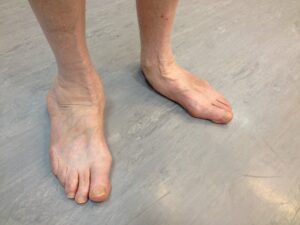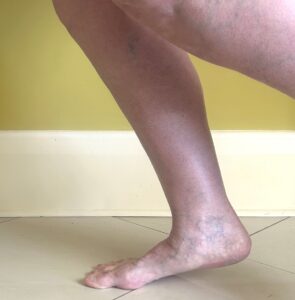Accessing appropriate foot care is often difficult, especially in underserved communities, due to long wait times, limited availability of foot health care and financial barriers that may delay diagnosis and treatment.12,13

FIGURES 2: Midfoot OA and flat feet (left), and midfoot flattening during heel raise (right). (Click to enlarge.)
Disparities in research amplify clinical bias, with under-representation across groups leaving gaps in knowledge and care.14 Certain populations often face systemic barriers, such as limited insurance coverage, transportation issues, and fewer culturally competent providers.15 Addressing these inequalities is essential for improving care and QoL for all people living with midfoot OA.
How Is It Evaluated Clinically?
Imaging
Radiographic diagnosis of midfoot OA has traditionally utilized the Kellgren-Lawrence system.16 More recently, the La Trobe Foot Atlas was developed to identify radiographic OA across four joints (medial and intermediate cuneiform-metatarsal joints, talonavicular joint and navicular-first cuneiform joint).17
 This atlas incorporates cardinal features of OA—osteophytes and joint space narrowing—allowing for four levels of severity and diagnosis of radiographic changes (scores ≥2) plus symptoms in the corresponding region. Magnetic resonance imaging (MRI), although less accessible than X-ray, may also be used with a semiquantitative scoring system that includes all joints of the midfoot.18
This atlas incorporates cardinal features of OA—osteophytes and joint space narrowing—allowing for four levels of severity and diagnosis of radiographic changes (scores ≥2) plus symptoms in the corresponding region. Magnetic resonance imaging (MRI), although less accessible than X-ray, may also be used with a semiquantitative scoring system that includes all joints of the midfoot.18
Physical Exam
Midfoot OA commonly presents as persistent dorsal midfoot pain, worsening with weight-bearing and high-stress activities on the midfoot (e.g., rising onto the ball of foot, walking up or down stairs). Tight footwear pressing on the top of the midfoot may also be painful.
Pain may be reproduced with joint palpation or movement, but the proximity of the joints can make anatomical localization and diagnosis challenging without imaging.
Tarsometatarsal (Lisfranc) involvement may be identified by stabilizing the hind foot and plantarflexing the respective metatarsal (i.e., piano key test), although diagnostic accuracy is not established.19 Dorsal osteophytes may be palpable in advanced cases but limited in earlier midfoot OA.20 Localized midfoot joint swelling may be present and this is best detected with ultrasound examination.21 For unilateral symptoms, comparison to the other foot may be useful.
Midfoot pain after an axial load to a plantarflexed foot (e.g., a stumble) or following direct blunt trauma should raise suspicion of Lisfranc ligament injury or fracture, warranting urgent imaging.
If a patient has night pain, neurological symptoms, persistent inflammation and swelling or signs of infection, more serious conditions should be considered and urgent investigation undertaken.
